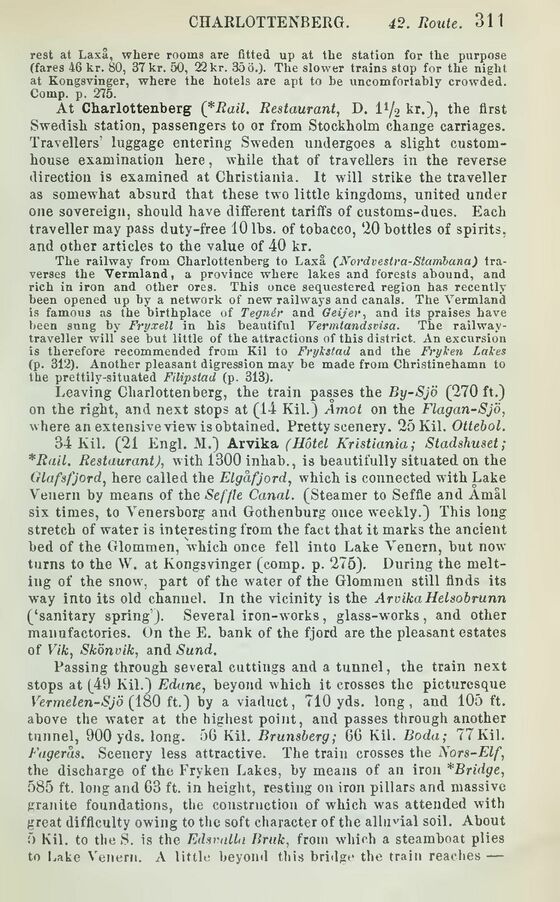
Full resolution (JPEG) - On this page / på denna sida - Sweden - Pages ...

<< prev. page << föreg. sida << >> nästa sida >> next page >>
Below is the raw OCR text
from the above scanned image.
Do you see an error? Proofread the page now!
Här nedan syns maskintolkade texten från faksimilbilden ovan.
Ser du något fel? Korrekturläs sidan nu!
This page has been proofread at least once.
(diff)
(history)
Denna sida har korrekturlästs minst en gång.
(skillnad)
(historik)
rest at Laxå, where rooms are fitted up at the station for the purpose
(fares 46 kr. 80, 37 kr. 50, 22 kr. 35 ö.). The slower trains stop for the night
at Kongsvinger, where the hotels are apt to he uncomfortably crowded.
Comp. p. 275.
At Charlottenberg (*Rail. Restaurant, D. 1½ kr.), the first
Swedish station, passengers to or from Stockholm change carriages.
Travellers’ luggage entering Sweden undergoes a slight customhouse
examination here, while that of travellers in the reverse
direction is examined at Christiania. It will strike the traveller
as somewhat absurd that these two little kingdoms, united under
one sovereign, should have different tariffs of customs-dues. Each
traveller may pass duty-free 10 lbs. of tobacco, 20 bottles of spirits,
and other articles to the value of 40 kr.
The railway from Charlottenberg to Laxå (Nordvestra-Stambana)
traverses the Vermland, a province where lakes and forests abound, and
rich in iron and other ores. This once sequestered region has recently
been opened up by a network of new railways and canals. The Vermland
is famous as the birthplace of Tegnér and Geijer, and its praises have
been sung by Fryxell in his beautiful Vermlandsvisa. The
railwaytraveller will see but little of the attractions of this district. An excursion
is therefore recommended from Kil to Frykstad and the Fryken Lakes
(p. 312). Another pleasant digression may be made from Christinehamn to
the prettily-situated Filipstad (p. 313).
Leaving Charlottenberg, the train passes the By-Sjö (270 ft.)
on the right, and next stops at (14 Kil.) Åmot on the Flagan-Sjö,
where an extensive view is obtained. Pretty scenery. 25 Kil. Ottebol.
34 Kil. (21 Engl. M.) Arvika (Hôtel Kristiania; Stadshuset;
*Rail. Restaurant), with 1300 inhab., is beautifully situated on the
Glafsfjord, here called the Elgåfjord, which is connected with Lake
Veuern by means of the Seffle Canal. (Steamer to Seffle and Åmål
six times, to Venersborg and Gothenburg once weekly.) This long
stretch of water is interesting from the fact that it marks the ancient
bed of the Glommen, which once fell into Lake Venern, but now
turns to the W. at Kongsvinger (comp. p. 275). During the melting
of the snow, part of the water of the Glommen still finds its
way into its old channel. In the vicinity is the Arvika Helsobrunn
(‘sanitary spring’). Several iron-works, glass-works , and other
manufactories. On the E. bank of the fjord are the pleasant estates
of Vik, Skönvik, and Sund.
Passing through several cuttings and a tunnel, the train next
stops at (49 Kil.) Edane, beyond which it crosses the picturesque
Vermelen-Sjö (180 ft.) by a viaduct, 710 yds. long, and 105 ft.
above the water at the highest point, and passes through another
tunnel, 900 yds. long. 56 Kil. Brunsberg; 66 Kil. Boda; 77 Kil.
Fagerås. Scenery less attractive. The train crosses the Nors-Elf,
the discharge of the Fryken Lakes, by means of an iron *Bridge,
585 ft. long and 63 ft. in height, resting on iron pillars and massive
granite foundations, the construction of which was attended with
great difficulty owing to the soft character of the alluvial soil. About
5 Kil. to the S. is the Edsvalla Bruk, from which a steamboat plies
to Lake Venern. A little beyond this bridge the train reaches —
<< prev. page << föreg. sida << >> nästa sida >> next page >>